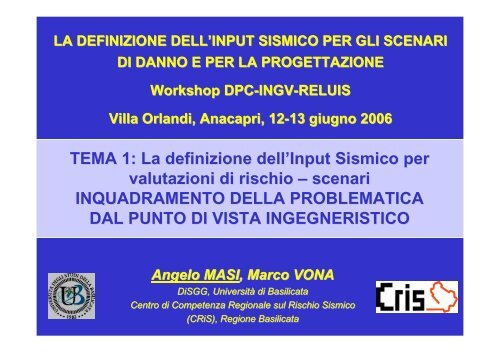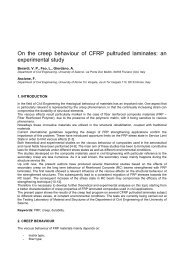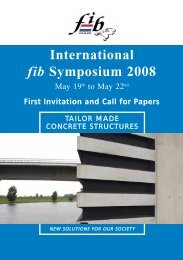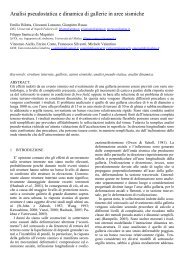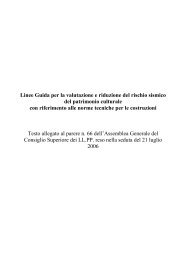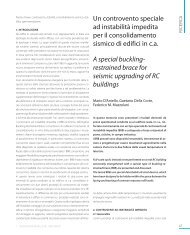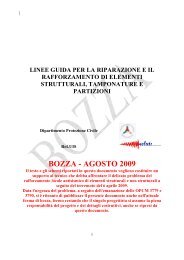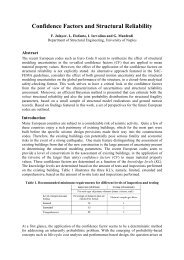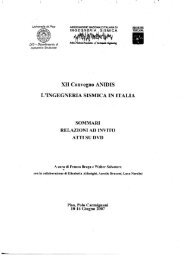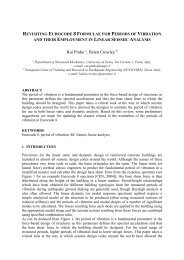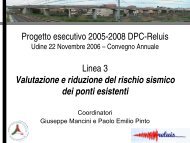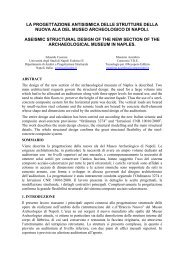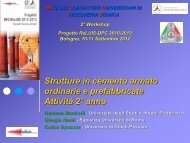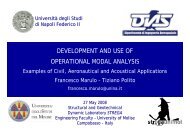TEMA 1: La definizione dell'Input Sismico per valutazioni ... - ReLUIS
TEMA 1: La definizione dell'Input Sismico per valutazioni ... - ReLUIS
TEMA 1: La definizione dell'Input Sismico per valutazioni ... - ReLUIS
Create successful ePaper yourself
Turn your PDF publications into a flip-book with our unique Google optimized e-Paper software.
LA DEFINIZIONE DELL’INPUT SISMICO PER GLI SCENARI<br />
DI DANNO E PER LA PROGETTAZIONE<br />
Angelo MASI Workshop DPC-<strong>ReLUIS</strong>-INGV Input sismico<br />
Workshop DPC-INGV<br />
INGV-RELUIS<br />
Villa Orlandi, Anacapri, , 12-13 13 giugno 2006<br />
<strong>TEMA</strong> 1: <strong>La</strong> <strong>definizione</strong> dell’Input <strong>Sismico</strong> <strong>per</strong><br />
<strong>valutazioni</strong> di rischio – scenari<br />
INQUADRAMENTO DELLA PROBLEMATICA<br />
DAL PUNTO DI VISTA INGEGNERISTICO<br />
Angelo MASI, , Marco VONA<br />
DiSGG, , Università di Basilicata<br />
Centro di Competenza Regionale sul Rischio <strong>Sismico</strong><br />
(CRiS), Regione Basilicata
PREPARAZIONE SCENARI DI DANNO<br />
Angelo MASI Workshop DPC-<strong>ReLUIS</strong>-INGV Input sismico<br />
Studio della sismicità<br />
storica<br />
Individuazione dell’evento<br />
sismico di riferimento<br />
Stima del danno<br />
Caratterizzazione tipologica<br />
degli edifici privati<br />
Valutazione della<br />
vulnerabilità<br />
Scenario dei danni strutturali e non strutturali<br />
Valutazione delle conseguenze attese sulla popolazione
CONSIDERAZIONI INTRODUTTIVE<br />
Angelo MASI Workshop DPC-<strong>ReLUIS</strong>-INGV Input sismico<br />
Tutti gli studi di bibliografia evidenziano la grande importanza<br />
dell’input sismico nella valutazione della risposta sismica delle<br />
strutture.<br />
<strong>La</strong> scelta del tipo di input da ado<strong>per</strong>are nelle analisi dipende<br />
fortemente dall’obiettivo:<br />
Predisposizione scenari input “realistico”<br />
Progettazione<br />
input “convenzionale”<br />
Nella predisposizione di Scenari come scegliere un input<br />
sismico che sia realistico ma al tempo stesso non dia luogo a<br />
risposte singolari ??
CONSIDERAZIONI INTRODUTTIVE<br />
Angelo MASI Workshop DPC-<strong>ReLUIS</strong>-INGV Input sismico<br />
Come viene espressa l’intensità negli scenari ??<br />
Nella preparazione di scenari l’evento di riferimento viene in genere<br />
espresso in termini di intensità macrosismica<br />
In Italia l’intensità più frequentemente ado<strong>per</strong>ata è la MCS<br />
Esempio<br />
Analisi di scenario effettuate dal DPC/USSN (SSN 2001, Orsini et al.<br />
2004)<br />
Che legame vi è tra intensità strumentale e macrosismica ??<br />
Può essere adottata una delle relazioni di Margottini et al., 1987:<br />
PGA=3.353*10 0.22 I_MCS I_MCS=(1/0.22)Log10(PGA/3.353)<br />
Servizio <strong>Sismico</strong> Nazionale, Il Rischio <strong>Sismico</strong>, Ingegneria Sismica, n. 1, 2001<br />
Orsini G., Di Pasquale G., Martini G., Lo Presti T., Il terremoto del 2002 in Molise e Puglia: lo scenario<br />
sismico, confronti tra stime preliminari e rilievi sul campo, Ingegneria Sismica, n. 1, 2004<br />
Margottini C., Molin D., Narcisi B., Serva L., Intensity vs. acceleration: italian data, Proceedings of Workshop<br />
on Historical Seismicity of Central-Eastern Mediterranean Region, Roma, 27-29 ottobre 1987
INTENSITÀ MACROSISMICA<br />
Angelo MASI Workshop DPC-<strong>ReLUIS</strong>-INGV Input sismico<br />
Che legame vi è tra le diverse scale macrosismiche ??<br />
Per trasformare l’intensità in scala MSK a partire dalla scala MCS, si può fare<br />
ancora riferimento a (Margottini et al., 1987) ottenendo il PGA in funzione<br />
dell’intensità MCS e MSK:<br />
PGA=3.353*10 0.22I_MCS<br />
PGA=2.279*10 0.258I_MCS<br />
Da cui si ottengono le seguenti relazioni tra I_MCS e I_MSK:<br />
I_MCS=1.17*I_MSK - 0.76 I_MSK=(I_MCS + 0.76)/1.17<br />
Il legame tra I_MSK e I_EMS viene<br />
commentato nel manuale della scala EMS98<br />
(ESC 1998), Chapter 4. The usage of intensity<br />
scales:<br />
In most cases there should be no difficulty in<br />
converting between MSK values and EMS<br />
values on the system MSK = EMS.<br />
ESC Working Group "Macroseismic Scales". European<br />
Macroseismic Scale 1998. GeoForschungsZentrum Potsdam,<br />
Germany, 1998.<br />
PGA<br />
0.05<br />
0.07<br />
0.1<br />
0.15<br />
0.2<br />
0.25<br />
0.3<br />
0.35<br />
I EMS<br />
V<br />
V-VI<br />
VI<br />
VII<br />
VII-VIII<br />
VIII<br />
VIII<br />
VIII-IX<br />
I MCS<br />
V-VI<br />
VI<br />
VII<br />
VIII<br />
IX<br />
IX-X<br />
X<br />
X
Angelo MASI Workshop DPC-<strong>ReLUIS</strong>-INGV Input sismico<br />
ESERCITAZIONE NAZIONALE DI<br />
PROTEZIONE CIVILE<br />
VAL D’AGRI 2006, 11 –14 maggio 2006<br />
SCENARI DI DANNO E CONSEGUENZE<br />
ATTESE SULLA POPOLAZIONE<br />
Angelo MASI (coordinatore), Marco MUCCIARELLI, Maria R.<br />
Gallipoli, Carmelinda SAMELA, Marco VONA, Giuseppe<br />
SANTARSIERO<br />
DiSGG, Università della Basilicata, Potenza<br />
Centro di Competenza sul Rischio <strong>Sismico</strong> della Regione Basilicata (CRiS)<br />
Regione Basilicata
ATTIVITA’ PREVISTE<br />
Angelo MASI Workshop DPC-<strong>ReLUIS</strong>-INGV Input sismico<br />
‣ Predisposizione di 3 scenari di danno e di conseguenze attese<br />
sulla popolazione conseguenti a:<br />
-3 scenari di evento forniti dall’INGV riferiti all’evento sismico del<br />
1857 (magnitudo equivalente 7.1, I_MCSmax = XI);<br />
-1 scenario di esposizione relativo ad un evento notturno (tutta la<br />
popolazione nelle proprie case).<br />
‣ Predisposizione di grafici e mappe GIS in cui siano rappresentati la<br />
vulnerabilità del patrimonio edilizio privato, i danni e le<br />
conseguenze attese sulla popolazione <strong>per</strong> i diversi scenari.<br />
‣ Collaborazione con le istituzioni e le altre strutture di Protezione<br />
Civile impegnate nell’esercitazione.<br />
‣ Attività di formazione – informazione – divulgazione rivolta ad<br />
amministratori e tecnici comunali, ad o<strong>per</strong>atori di volontariato ed al<br />
mondo della scuola.
AREA COINVOLTA NELL’ESERCITAZIONE<br />
Angelo MASI Workshop DPC-<strong>ReLUIS</strong>-INGV Input sismico<br />
VAL D’AGRI, , BASILICATA<br />
Comuni interessati<br />
Armento<br />
Gallicchio<br />
Grumento Nova<br />
Marsico Nuovo<br />
Marsicovetere<br />
Missanello<br />
Moliterno<br />
Montemurro<br />
Paterno<br />
Roccanova<br />
S. Chirico<br />
S. Martino d'Agri<br />
Sant'Arcangelo<br />
Sarconi<br />
Spinoso<br />
Tramutola<br />
Viggiano
SCENARI DI EVENTO<br />
Angelo MASI Workshop DPC-<strong>ReLUIS</strong>-INGV Input sismico<br />
Gli scenari di evento sono stati forniti dall’Istituto Nazionale di<br />
Geofisica e Vulcanologia ed elaborati dal Prof. Marco Mucciarelli<br />
del DiSGG.<br />
Sono stati predisposti 3 scenari di evento:<br />
• Scenario 1 (SE) 15.700 E 40.425 N M = 6.9<br />
• Scenario 2 (BI) 15.800 E 40.350 N M = 6.9<br />
• Scenario 3 (NW) 15.875 E 40.275 N M = 6.9<br />
Scenario di evento SE<br />
Scenario di evento BI<br />
“Scenario estratto”<br />
Scenario di evento NW
SCENARI DI EVENTO<br />
Scenario 1<br />
Scenario 2<br />
Scenario 3<br />
Scenario 3<br />
Angelo MASI Workshop DPC-<strong>ReLUIS</strong>-INGV Input sismico<br />
COMUNE<br />
Marsico Nuovo<br />
Marsicovetere<br />
Paterno<br />
Tramutola<br />
Viggiano<br />
Grumento Nova<br />
Moliterno<br />
Sarconi<br />
Spinoso<br />
Montemurro<br />
Armento<br />
S. Martino D'Agri<br />
S. Chirico<br />
Roccanova<br />
Sant'Arcangelo<br />
Missanello<br />
Gallicchio<br />
MCS_SE<br />
9<br />
9<br />
9<br />
9<br />
10<br />
10<br />
10<br />
10<br />
10<br />
10<br />
9<br />
9<br />
9<br />
8<br />
8<br />
9<br />
9<br />
MCS_BI<br />
10<br />
9<br />
10<br />
9<br />
9<br />
9<br />
9<br />
9<br />
9<br />
9<br />
8<br />
8<br />
8<br />
7<br />
7<br />
8<br />
8<br />
MCS_NW<br />
10<br />
9<br />
10<br />
9<br />
9<br />
9<br />
8<br />
8<br />
8<br />
8<br />
7<br />
7<br />
7<br />
6<br />
6<br />
7<br />
7<br />
EMS_NW<br />
9<br />
8-9<br />
8-9<br />
8-9<br />
8-9<br />
8-9<br />
7-8<br />
7-8<br />
7-8<br />
7-8<br />
6-7<br />
6-7<br />
6-7<br />
6<br />
6<br />
6-7<br />
6-7
Vulnerabilità degli edifici ad uso privato<br />
Angelo MASI Workshop DPC-<strong>ReLUIS</strong>-INGV Input sismico<br />
Classi di vulnerabilità in termini di numero di edifici<br />
42%<br />
24%<br />
39%<br />
11%<br />
20%<br />
14%<br />
8%<br />
47%<br />
14%<br />
43%<br />
42%<br />
37%<br />
11%<br />
4%<br />
11%<br />
32%<br />
28%<br />
40%<br />
6%<br />
8%<br />
12%<br />
13%<br />
48%<br />
48%<br />
5%<br />
3%<br />
46%<br />
50%<br />
44%<br />
18%<br />
5%<br />
1%<br />
30%<br />
5%<br />
44%<br />
36%<br />
4%<br />
2% 58%<br />
30%<br />
15%<br />
47%<br />
5%<br />
11%<br />
50%<br />
28%<br />
8%<br />
15%<br />
3%<br />
53%<br />
7%<br />
13%<br />
75%<br />
14%<br />
8%<br />
65%<br />
16%<br />
8%<br />
10%<br />
66%<br />
Classe A<br />
Classe B<br />
Classe C<br />
Classe D
Marsico Vetere: conseguenze attese sulla popolazione<br />
400<br />
350<br />
300<br />
250<br />
200<br />
150<br />
100<br />
50<br />
0<br />
400<br />
350<br />
300<br />
250<br />
200<br />
150<br />
100<br />
50<br />
0<br />
400<br />
350<br />
300<br />
250<br />
200<br />
150<br />
100<br />
50<br />
0<br />
A B C D<br />
Classi di Vulnerabilità<br />
A B C D<br />
Classi di Vulnerabilità<br />
A B C D<br />
Classi di Vulnerabilità<br />
0.10<br />
0.08<br />
0.06<br />
0.04<br />
0.02<br />
0.00<br />
0.10<br />
0.08<br />
0.06<br />
0.04<br />
0.02<br />
0.00<br />
0.10<br />
0.08<br />
0.06<br />
0.04<br />
0.02<br />
0.00<br />
40<br />
35<br />
30<br />
25<br />
20<br />
15<br />
10<br />
5<br />
EMS-NE VIII-IXIX EMS-BI VIII-IXIX EMS-SW SW VIII-IXIX<br />
N° Abitanti Senzatetto<br />
% Abitanti<br />
N° Feriti<br />
0<br />
A B C D<br />
Classi di Vulnerabilità<br />
0.01<br />
% Abitanti<br />
40<br />
35<br />
30<br />
25<br />
20<br />
15<br />
10<br />
5<br />
0<br />
A B C D<br />
Classi di Vulnerabilità<br />
0.012<br />
0.010<br />
0.008<br />
0.006<br />
0.004<br />
0.002<br />
0.000<br />
40<br />
35<br />
30<br />
25<br />
20<br />
15<br />
10<br />
5<br />
0.01<br />
N° Vittime<br />
% Abitanti<br />
N° Abitanti Senzatetto<br />
% Abitanti<br />
N° Feriti<br />
0<br />
A B C D<br />
Classi di Vulnerabilità<br />
0.01<br />
% Abitanti<br />
40<br />
35<br />
30<br />
25<br />
20<br />
15<br />
10<br />
5<br />
0<br />
A B C D<br />
Classi di Vulnerabilità<br />
0.012<br />
0.010<br />
0.008<br />
0.006<br />
0.004<br />
0.002<br />
0.000<br />
40<br />
35<br />
30<br />
25<br />
20<br />
15<br />
10<br />
5<br />
0.01<br />
N° Vittime<br />
% Abitanti<br />
N° Abitanti Senzatetto<br />
% Abitanti<br />
N° Feriti<br />
0<br />
A B C D<br />
Classi di Vulnerabilità<br />
0.01<br />
% Abitanti<br />
40<br />
35<br />
30<br />
25<br />
20<br />
15<br />
10<br />
5<br />
0<br />
A B C D<br />
Classi di Vulnerabilità<br />
0.012<br />
0.010<br />
0.008<br />
0.006<br />
0.004<br />
0.002<br />
0.000<br />
0.01<br />
N° Vittime<br />
% Abitanti<br />
0.00<br />
0.00<br />
0.00<br />
Angelo MASI Workshop DPC-<strong>ReLUIS</strong>-INGV Input sismico
ATTIVITÀ IN CORSO<br />
Angelo MASI Workshop DPC-<strong>ReLUIS</strong>-INGV Input sismico<br />
Progetto Triennale 2005–2008 – DPC/RELUIS<br />
Linea 10 - Definizione e sviluppo di archivi di dati <strong>per</strong> la<br />
valutazione del rischio, la pianificazione e la gestione<br />
dell’emergenza (Coordinatore: D. Liberatore)<br />
Progetti sismologici DPC/INGV<br />
Progetto S3 - Scenari di scuotimento in aree di interesse<br />
prioritario e/o strategico (coordinatori: F. Pacor e M.<br />
Mucciarelli)
ATTIVITÀ IN CORSO<br />
Angelo MASI Workshop DPC-<strong>ReLUIS</strong>-INGV Input sismico<br />
ECEES 2006 - Common Session CS6<br />
Early warning, shaking and loss scenarios<br />
On Shaking and Loss Scenarios<br />
A significant effort went during the last few years into research on ground shaking and loss<br />
scenarios: besides national studies (e.g. on the cities of Catania, Thessaloniki, Lisbon), the EC<br />
Risk_UE project (2001-2004) was entirely devoted to developing a European based approach to<br />
earthquake scenarios and to applying it to seven cities directly involved in the project.<br />
Within the ongoing LessLoss IP of the EC, begun in 2004, two subprojects deal with loss<br />
scenarios and mitigation measures (for buildings and for infrastructure systems).<br />
Ground shaking representations<br />
Computational seismologists favour advanced source and wave propagation modelling to predict<br />
the ground motions expected in an urban area.<br />
However, especially in Europe, observations for calibrating damage estimations for large<br />
numbers of buildings, e. g. through DPM (Damage Probability Matrices), use mostly<br />
macroseismic intensity to describe shaking.<br />
More elaborate approaches use nonlinear mechanical models to predict the <strong>per</strong>formance of<br />
engineering structures, and the response spectrum to represent seismic demand, but are not as<br />
extensively calibrated as those based on intensity.<br />
Under these circumstances, are synthetic ground motions generated by<br />
sophisticated simulations really justified in scenario practice?<br />
Should we not favour the simpler approaches?
QUALE INPUT ADOTTARE ?<br />
Angelo MASI Workshop DPC-<strong>ReLUIS</strong>-INGV Input sismico<br />
Le caratteristiche dell’input sismico (SI) da adottare<br />
dipendono dal modello di vulnerabilità e di stima del<br />
danno (DEM) adottati e/o disponibili<br />
DEM<br />
Matrici di probabilità<br />
di danno, DPM<br />
(probabilistiche)<br />
Curve di Fragilità,<br />
FC (probabilistiche)<br />
Curve di danno, DC<br />
(deterministiche)<br />
SI<br />
Intensità macrosismica<br />
(I MCS , I MSK , I EMS )<br />
Intensità spettrale<br />
(S d , S v , S a )<br />
Intensità strumentale<br />
(PGA, I A , I H , …)<br />
Irpinia ’80<br />
EMS-98<br />
HAZUS<br />
RISK-UE<br />
Riferimenti<br />
Convenzioni UniBas-SSN<br />
Studi Masi et al., Cosenza et<br />
al., Elnashai, Elenas, ..
DPM e Classi di Vulnerabilità Irpinia ‘80<br />
Angelo MASI Workshop DPC-<strong>ReLUIS</strong>-INGV Input sismico<br />
Le tredici tipologie principali rilevate dopo il sisma ’80 sono<br />
state raggruppate nelle tre classi di vulnerabilità (A, B, C)<br />
considerate nella scala macrosismica MSK-76 (Braga, Dolce e<br />
Liberatore, 1982)<br />
S t r u t t u r e<br />
o r i z z o n t a l i<br />
S i s t e m i a v o l t e<br />
o m i s t i<br />
M u ra tu ra in<br />
p i e t r a m e<br />
n o n<br />
sq u ad rato<br />
S t r u t t u r e v e r t i c a l i<br />
M u ra tu ra<br />
in<br />
p i e t r a m e<br />
s b o z z a t o<br />
M u ra tu ra<br />
in m a tto n i<br />
o b l o c c h i<br />
A A A<br />
S o la i in le g n o A A B<br />
S o l a i c o n<br />
p u tre lle<br />
S o la i o s o le tte in<br />
c e m e n t o a r m a t o<br />
B B C<br />
C e m e n t o<br />
a r m a t o<br />
C C C C<br />
Le tre classi A, B e C sono relative, principalmente, alle<br />
costruzioni realizzate in assenza di norme sismiche, in quanto<br />
gran parte del territorio interessato dal sisma del 1980 e dal<br />
successivo rilievo fu classificato come sismico solo dopo il 1980.
Distribuzioni di danno <strong>per</strong> la classe di vulnerabilità A<br />
Angelo MASI Workshop DPC-<strong>ReLUIS</strong>-INGV Input sismico<br />
frequenza danno<br />
0,80<br />
0,70<br />
0,60<br />
0,50<br />
0,40<br />
0,30<br />
0,20<br />
0,10<br />
0,00<br />
Classe A PDF<br />
I_EMS p 0 1 2 3 4 5<br />
VI 0,284 0,188 0,373 0,296 0,117 0,023 0,002<br />
VII 0,423 0,064 0,234 0,344 0,252 0,092 0,014<br />
VIII 0,725 0,002 0,021 0,109 0,288 0,380 0,200<br />
IX 0,87 0,000 0,001 0,017 0,111 0,372 0,498<br />
X 0,94 0,000 0,000 0,002 0,030 0,234 0,734<br />
CDF<br />
I_EMS p 0 1 2 3 4 5<br />
VI 0,284 0,188 0,561 0,857 0,975 0,998 1,000<br />
VII 0,423 0,064 0,298 0,642 0,894 0,986 1,000<br />
VIII 0,725 0,002 0,022 0,132 0,420 0,800 1,000<br />
IX 0,87 0,000 0,001 0,018 0,129 0,502 1,000<br />
X 0,94 0,000 0,000 0,002 0,032 0,266 1,000<br />
PDF classe A<br />
0 1 2 3 4 5<br />
Livello di danno<br />
I = VI<br />
I = VII<br />
I = VIII<br />
I = IX<br />
I = X<br />
frquenza cumulativa<br />
1,00<br />
0,90<br />
0,80<br />
0,70<br />
0,60<br />
0,50<br />
0,40<br />
0,30<br />
0,20<br />
0,10<br />
0,00<br />
CDF classe A<br />
0 1 2 3 4 5<br />
Livello di danno<br />
I = VI<br />
I = VII<br />
I = VIII<br />
I = IX<br />
I = X
Ampliamento DPM<br />
Angelo MASI Workshop DPC-<strong>ReLUIS</strong>-INGV Input sismico<br />
Per considerare la presenza di edifici antisismici o adeguati<br />
è stata successivamente introdotta un'ulteriore classe a minore<br />
vulnerabilità (classe D).<br />
<strong>La</strong> relativa DPM è stata ricavata da Dolce, Masi e Vona a<br />
partire dalle DPM già disponibili e tenendo conto delle<br />
indicazioni tratte dalla scala EMS98<br />
Strutture<br />
o r i z z o n t a l i<br />
S iste m i a v o lte o<br />
m i s t i<br />
S o la i in le g n o c o n o<br />
sen za caten e<br />
S o la i in p u tre lle c o n<br />
o s e n z a c a t e n e<br />
S o la i o so le tte in<br />
cem ento arm ato<br />
E d ific i a n tisism ic i o<br />
adeguati<br />
M u r a t u r a<br />
d i q u a l i t à<br />
scadente<br />
Strutture verticali<br />
M u r a t u r a<br />
d i q u a lità<br />
m e d i a<br />
M u r a t u r a<br />
d i b u o n a<br />
q u a l i t à<br />
A A A<br />
A A B<br />
B B C<br />
C e m e n t o<br />
arm ato<br />
B C C C<br />
D D D D
CLASSI DI VULNERABILITÀ EMS 98<br />
Angelo MASI Workshop DPC-<strong>ReLUIS</strong>-INGV Input sismico
CLASSI DI VULNERABILITÀ EMS98<br />
Angelo MASI Workshop DPC-<strong>ReLUIS</strong>-INGV Input sismico<br />
Tabella di vulnerabilità – Edifici in c.a.<br />
MATERIALE<br />
TIPOLOGIA STRUTTURALE<br />
CEMENTO Telai senza o con bassa antisismicità (L-ERD)<br />
ARMATO Telai con moderata antisismicità (M-ERD)<br />
Telai con elevata antisismicità (H-ERD)<br />
Pareti senza o con bassa antisismicità (L-ERD)<br />
Pareti con moderata antisismicità (M-ERD)<br />
Pareti con elevata antisismicità (H-ERD)<br />
Classe di vulnerabilità più probabile<br />
Intervallo di variazione probabile<br />
Intervallo di variazione meno probabile, casi eccezionali<br />
CLASSE DI<br />
VULNERABILITÀ<br />
A B C D E F
QUALE INPUT ADOTTARE ?<br />
Angelo MASI Workshop DPC-<strong>ReLUIS</strong>-INGV Input sismico<br />
Le caratteristiche dell’input sismico (SI) da adottare<br />
dipendono dal modello di vulnerabilità e di stima del<br />
danno (DEM) adottati e/o disponibili<br />
DEM<br />
Matrici di probabilità<br />
di danno, DPM<br />
(probabilistiche)<br />
Curve di Fragilità,<br />
FC (probabilistiche)<br />
Curve di danno, DC<br />
(deterministiche)<br />
SI<br />
Intensità macrosismica<br />
(I MCS , I MSK , I EMS )<br />
Intensità spettrale<br />
(S d , S v , S a )<br />
Intensità strumentale<br />
(PGA, I A , I H , …)<br />
Irpinia ’80<br />
EMS-98<br />
HAZUS<br />
RISK-UE<br />
Riferimenti<br />
Convenzioni UniBas-SSN<br />
Studi Masi et al., Cosenza et<br />
al., Elnashai, Elenas, ..
CURVE DI FRAGILITÀ HAZUS<br />
HAZUS – Multi-Hazard: FEMA’s GISbased,<br />
Multi-hazard Risk Assessment<br />
Program for Analyzing Potential Losses<br />
Angelo MASI Workshop DPC-<strong>ReLUIS</strong>-INGV Input sismico
METODOLOGIA<br />
Angelo MASI Workshop DPC-<strong>ReLUIS</strong>-INGV Input sismico
CLASSIFICAZIONE DEGLI EDIFICI<br />
Angelo MASI Workshop DPC-<strong>ReLUIS</strong>-INGV Input sismico<br />
Nell’individuazione delle classi sono considerati i seguenti<br />
aspetti:<br />
• Tipologia strutturale<br />
• Altezza<br />
• Livello di progettazione antisismica<br />
• Qualità costruttiva<br />
• Parametri strutturali che influenzano la resistenza sismica<br />
• Elementi non strutturali suscettibili di danno<br />
• Pratiche costruttive regionali<br />
• Variabilità dei parametri all’interno delle classi<br />
• Le classi riprendono le indicazioni riportate nelle norme<br />
FEMA 178.<br />
• <strong>La</strong> classificazione degli edifici è fatta anche sulla base<br />
della destinazione d’uso
Classificazione tipologie edilizie<br />
Angelo MASI Workshop DPC-<strong>ReLUIS</strong>-INGV Input sismico<br />
Esempio<br />
<strong>La</strong> classe C1L include<br />
gli edifici in cemento<br />
armato a struttura<br />
intelaiata (Concrete<br />
Moment Frame), bassi<br />
(Low-Rise) ossia con un<br />
numero di piani<br />
compreso tra 1 e 3.<br />
Sono previste in<br />
totale 36 tipologie<br />
edilizie
Classificazione Livello di Prog. Sismica e Qualità Costruttiva<br />
Angelo MASI Workshop DPC-<strong>ReLUIS</strong>-INGV Input sismico
DANNO FISICO<br />
Angelo MASI Workshop DPC-<strong>ReLUIS</strong>-INGV Input sismico<br />
<strong>La</strong> severità del danno agli edifici è descritta da 5 livelli:<br />
1. Nullo<br />
2. Lieve <br />
3. Moderato <br />
4. Esteso <br />
5. Totale <br />
Si noti la differenza con la classificazione del danno della EMS98, che<br />
prevede 5 livelli di danno, oltre al danno nullo.<br />
Si può ritenere che il danno 4-5 della EMS98 coincida con danno totale.
CURVE DI CAPACITA’<br />
Angelo MASI Workshop DPC-<strong>ReLUIS</strong>-INGV Input sismico
CURVE DI CAPACITA’<br />
Angelo MASI Workshop DPC-<strong>ReLUIS</strong>-INGV Input sismico
CURVE DI CAPACITA’<br />
Angelo MASI Workshop DPC-<strong>ReLUIS</strong>-INGV Input sismico
CURVE DI FRAGILITÀ<br />
Angelo MASI Workshop DPC-<strong>ReLUIS</strong>-INGV Input sismico<br />
• Le curve esprimono la probabilità di raggiungimento di un<br />
prefissato livello di danno in funzione ad es. dello<br />
spostamento spettrale
CURVE DI FRAGILITÀ<br />
Angelo MASI Workshop DPC-<strong>ReLUIS</strong>-INGV Input sismico<br />
• Ogni curva di fragilità è definita dal valore medio del parametro sismico<br />
(spostamento spettrale Sd, Sa) in corrispondenza del quale si raggiunge la<br />
soglia di uno stato di danneggiamento.<br />
• I valori medi degli spostamenti spettrali e la loro variabilità sono<br />
determinati, <strong>per</strong> ogni classe di edificio individuata e livello di danno, sulla<br />
base di combinazioni di dati forniti da terremoti passati e giudizi es<strong>per</strong>ti.<br />
• <strong>La</strong> probabilità condizionata di raggiungere o su<strong>per</strong>are un livello di danno ds,<br />
dato lo spostamento spettrale Sd è data da:<br />
S<br />
d , ds<br />
β ds<br />
Φ<br />
P<br />
[ ds | S ]<br />
d<br />
⎡ 1<br />
= Φ⎢<br />
⎢⎣<br />
β<br />
ds<br />
⎛<br />
⎜<br />
S<br />
ln<br />
⎝ S<br />
è il valore medio dello spostamento spettrale a cui l’edificio raggiunge il<br />
livello di danno ds<br />
è la deviazione standard del logaritmo naturale dello spostamento<br />
spettrale <strong>per</strong> il livello di danno ds<br />
è la funzione cumulativa normale standard<br />
d<br />
d , ds<br />
⎞⎤<br />
⎟<br />
⎥<br />
⎠⎥⎦
CURVE DI FRAGILITÀ<br />
Angelo MASI Workshop DPC-<strong>ReLUIS</strong>-INGV Input sismico
QUADRO DI SINTESI<br />
Angelo MASI Workshop DPC-<strong>ReLUIS</strong>-INGV Input sismico
RISK -UE<br />
Matrice delle tipologie <strong>per</strong> edifici in muratura (27 tipologie)<br />
Angelo MASI Workshop DPC-<strong>ReLUIS</strong>-INGV Input sismico
RISK -UE<br />
Matrice delle tipologie <strong>per</strong> edifici c.a. (21 tipologie)<br />
Angelo MASI Workshop DPC-<strong>ReLUIS</strong>-INGV Input sismico
RISK -UE<br />
Matrice delle tipologie <strong>per</strong> edifici in acciaio e in legno<br />
(17 tipologie)<br />
Angelo MASI Workshop DPC-<strong>ReLUIS</strong>-INGV Input sismico
RISK -UE<br />
Angelo MASI Workshop DPC-<strong>ReLUIS</strong>-INGV Input sismico
RISK -UE<br />
Alcune proposte di curve di fragilità <strong>per</strong> la tipologia<br />
RC1M HC (RC moment frames, Mid-rise, High Code)<br />
Angelo MASI Workshop DPC-<strong>ReLUIS</strong>-INGV Input sismico
QUALE INPUT ADOTTARE ?<br />
Angelo MASI Workshop DPC-<strong>ReLUIS</strong>-INGV Input sismico<br />
Le caratteristiche dell’input sismico (SI) da adottare<br />
dipendono dal modello di vulnerabilità e di stima del<br />
danno (DEM) adottati e/o disponibili<br />
DEM<br />
Matrici di probabilità<br />
di danno, DPM<br />
(probabilistiche)<br />
Curve di Fragilità,<br />
FC (probabilistiche)<br />
Curve di danno, DC<br />
(deterministiche)<br />
SI<br />
Intensità macrosismica<br />
(I MCS , I MSK , I EMS )<br />
Intensità spettrale<br />
(S d , S v , S a )<br />
Intensità strumentale<br />
(PGA, I A , I H , …)<br />
Irpinia ’80<br />
EMS-98<br />
HAZUS<br />
RISK-UE<br />
Riferimenti<br />
Convenzioni UniBas-SSN<br />
Studi Masi et al., Cosenza et<br />
al., Elnashai, Elenas, ..
INTENSITÀ STRUMENTALE: Parametri sismici<br />
Angelo MASI Workshop DPC-<strong>ReLUIS</strong>-INGV Input sismico<br />
I parametri sismici sono ricavati dalla registrazione<br />
dell’evento e possono essere utilizzati <strong>per</strong> valutare il<br />
potenziale distruttivo dell’evento.<br />
• Parametri di picco: PGA, PGV, PGD, rapporti tra<br />
essi<br />
• Parametri integrali: Intensità di Arias I A , fattore<br />
di Saragoni P D , Intensità di Housner I H<br />
• Durata: durata efficace di Trifunac e Brady t d
PARAMETRI SISMICI: Definizioni<br />
Angelo MASI Workshop DPC-<strong>ReLUIS</strong>-INGV Input sismico<br />
2<br />
Intensità di Arias I A I a ()<br />
A<br />
π<br />
= ⋅∫<br />
Fattore di Saragoni P D<br />
P D = I A / (υ 0 ) 2<br />
25 .<br />
Intensità di Housner I H<br />
H<br />
01 .<br />
pv<br />
Durata efficace di<br />
Trifunac e Brady t d<br />
2g<br />
t<br />
0<br />
t dt<br />
( ξ 005)<br />
I = ∫ S T, = . dT<br />
Intervallo di tempo che<br />
intercorre tra il 5% ed il 95%<br />
dell’intensità di Arias I A
UN ESEMPIO: Kwon, Elnashai, The effect of material and ground motion uncertainty on the<br />
seismic vulnerability curves of RC structure, Engineering Structures 28 (2006)<br />
Angelo MASI Workshop DPC-<strong>ReLUIS</strong>-INGV Input sismico<br />
Curve di<br />
vulnerabilità <strong>per</strong><br />
diversi set di<br />
accelerogrammi<br />
(a/v=PGA/PGV)<br />
Serviceability<br />
Limit State<br />
Collapse Prevention<br />
Limit State
UN ESEMPIO: Kwon, Elnashai, The effect of material and ground motion uncertainty on the<br />
seismic vulnerability curves of RC structure, Engineering Structures 28 (2006)<br />
Angelo MASI Workshop DPC-<strong>ReLUIS</strong>-INGV Input sismico<br />
CONCLUSION<br />
• ….<br />
• At high ground motion levels, material pro<strong>per</strong>ties contribute to the<br />
variability in structural response, but the resulting variability is<br />
much smaller than that due to ground motion variability.<br />
• Input motion characteristics have a most significant effect on<br />
vulnerability curves. Therefore, meticulous consideration is<br />
required when ground motions are selected.<br />
Il ruolo dell’input appare molto più importante delle<br />
proprietà dei materiali.<br />
Ci potrebbe essere un problema: la variabilità delle<br />
proprietà dei materiali viene considerata soltanto nel calcolo<br />
della domanda e non nel calcolo della capacità (ISD limite)
INPUT SISMICO<br />
Angelo MASI Workshop DPC-<strong>ReLUIS</strong>-INGV Input sismico<br />
Accelerogrammi naturali<br />
• 30 registrazioni di area euro asiatica (dalla Banca Dati Europea)<br />
• PGA 0.04 ÷ 0.36 g<br />
• Intensità di Arias 0.03 – 2.88 m/s<br />
Accelerogrammi artificiali<br />
• Spettro EC8 <strong>per</strong> terreno di tipo B<br />
• SIMQKE, BELFAGOR<br />
• PGA 0.06 ÷ 0.42 g<br />
Se / ag<br />
3<br />
2.5<br />
2<br />
1.5<br />
1<br />
0.5<br />
0<br />
0 1 2 3 4 5<br />
T [s]
Angelo MASI Workshop DPC-<strong>ReLUIS</strong>-INGV Input sismico<br />
Caratteristiche accelerogrammi naturali<br />
1.8387E-03<br />
2.80<br />
0.70<br />
52.00<br />
16.19<br />
2.88<br />
47.79<br />
0.363<br />
30<br />
4.5400E-04<br />
0.95<br />
1.92<br />
18.80<br />
11.11<br />
1.31<br />
27.15<br />
0.361<br />
29<br />
2.5522E-04<br />
0.49<br />
2.54<br />
13.63<br />
2.99<br />
0.74<br />
36.26<br />
0.346<br />
28<br />
9.8635E-04<br />
0.96<br />
1.35<br />
25.02<br />
21.57<br />
1.46<br />
39.94<br />
0.338<br />
27<br />
1.8970E-03<br />
0.54<br />
2.06<br />
16.01<br />
11.12<br />
0.61<br />
48.30<br />
0.330<br />
26<br />
1.7939E-04<br />
0.58<br />
2.03<br />
16.22<br />
4.01<br />
0.44<br />
23.10<br />
0.329<br />
25<br />
1.6678E-04<br />
0.63<br />
1.80<br />
17.25<br />
5.09<br />
0.68<br />
45.97<br />
0.310<br />
24<br />
6.5238E-03<br />
2.34<br />
0.57<br />
53.99<br />
11.01<br />
1.95<br />
48.20<br />
0.306<br />
23<br />
1.8974E-04<br />
0.36<br />
3.03<br />
9.92<br />
2.49<br />
0.38<br />
18.14<br />
0.300<br />
22<br />
1.0147E-04<br />
0.75<br />
2.12<br />
13.95<br />
15.85<br />
1.24<br />
60.00<br />
0.296<br />
21<br />
2.3428E-05<br />
0.23<br />
3.75<br />
7.85<br />
3.11<br />
0.50<br />
7.74<br />
0.294<br />
20<br />
2.3607E-03<br />
0.38<br />
2.48<br />
11.31<br />
4.69<br />
0.57<br />
56.19<br />
0.281<br />
19<br />
6.8225E-04<br />
1.04<br />
1.18<br />
22.45<br />
5.52<br />
0.34<br />
39.04<br />
0.265<br />
18<br />
3.3761E-04<br />
0.31<br />
3.39<br />
7.48<br />
4.78<br />
0.34<br />
23.10<br />
0.253<br />
17<br />
8.1575E-04<br />
1.30<br />
0.72<br />
32.94<br />
4.03<br />
0.27<br />
21.58<br />
0.237<br />
16<br />
8.9747E-04<br />
0.45<br />
1.96<br />
11.83<br />
1.76<br />
0.37<br />
18.56<br />
0.232<br />
15<br />
6.4528E-04<br />
0.40<br />
2.13<br />
10.82<br />
4.96<br />
0.26<br />
19.79<br />
0.231<br />
14<br />
4.3875E-04<br />
0.97<br />
0.91<br />
25.20<br />
12.85<br />
0.63<br />
41.84<br />
0.230<br />
13<br />
1.0915E-03<br />
1.68<br />
0.36<br />
59.58<br />
5.49<br />
0.60<br />
25.83<br />
0.215<br />
12<br />
9.5010E-04<br />
0.40<br />
1.97<br />
10.82<br />
4.61<br />
0.38<br />
22.00<br />
0.214<br />
11<br />
6.1860E-04<br />
0.40<br />
1.83<br />
10.32<br />
4.03<br />
0.27<br />
21.47<br />
0.189<br />
10<br />
1.0614E-04<br />
0.17<br />
2.96<br />
6.23<br />
4.93<br />
0.14<br />
26.12<br />
0.185<br />
9<br />
2.1224E-04<br />
0.20<br />
2.49<br />
6.68<br />
6.02<br />
0.14<br />
33.60<br />
0.166<br />
8<br />
3.1562E-04<br />
0.30<br />
1.83<br />
8.58<br />
7.12<br />
0.16<br />
28.26<br />
0.157<br />
7<br />
2.8496E-05<br />
0.22<br />
2.12<br />
6.77<br />
3.47<br />
0.13<br />
59.84<br />
0.143<br />
6<br />
1.4113E-04<br />
0.17<br />
2.55<br />
5.18<br />
6.08<br />
0.10<br />
33.58<br />
0.132<br />
5<br />
7.5155E-05<br />
0.18<br />
2.70<br />
3.65<br />
9.89<br />
0.06<br />
30.68<br />
0.099<br />
4<br />
4.0637E-05<br />
0.14<br />
1.91<br />
4.08<br />
6.80<br />
0.05<br />
40.47<br />
0.078<br />
3<br />
1.3568E-05<br />
0.16<br />
1.75<br />
3.74<br />
8.26<br />
0.04<br />
65.00<br />
0.066<br />
2<br />
8.9682E-05<br />
0.09<br />
1.80<br />
2.05<br />
15.05<br />
0.03<br />
24.57<br />
0.037<br />
1<br />
[g/ms -1 ]<br />
[cm/s]<br />
[m/s]<br />
PD<br />
I H<br />
PGA / PGV<br />
PGV<br />
td<br />
I A<br />
tmax<br />
PGA<br />
N°<br />
Accelerogrmma 15<br />
0<br />
0.2<br />
0.4<br />
0.6<br />
0.8<br />
1<br />
1.2<br />
1.4<br />
1.6<br />
1.8<br />
0 1 2 3 4 5<br />
[s]<br />
[g]<br />
Accelerogrmma 24<br />
0<br />
0.2<br />
0.4<br />
0.6<br />
0.8<br />
1<br />
1.2<br />
1.4<br />
1.6<br />
1.8<br />
0 1 2 3 4 5<br />
[s]<br />
[g]<br />
Accelerogrmma 30<br />
0<br />
0.2<br />
0.4<br />
0.6<br />
0.8<br />
1<br />
1.2<br />
1.4<br />
1.6<br />
1.8<br />
0 1 2 3 4 5<br />
[s]<br />
[g]
Caratteristiche accelerogrammi SIMQKE<br />
Angelo MASI Workshop DPC-<strong>ReLUIS</strong>-INGV Input sismico<br />
SIMQKE<br />
t1<br />
[s]<br />
2.6<br />
2.6<br />
3.3<br />
4.0<br />
4.6<br />
5.3<br />
6.0<br />
t2<br />
[s]<br />
10.0<br />
10.0<br />
12.5<br />
15.0<br />
17.5<br />
20.0<br />
22.5<br />
[g]<br />
t3<br />
[s]<br />
2.0<br />
2.0<br />
2.5<br />
3.0<br />
3.5<br />
4.0<br />
4.5<br />
0.1<br />
0.08<br />
0.06<br />
0.04<br />
0.02<br />
0<br />
-0.02<br />
-0.04<br />
-0.06<br />
-0.08<br />
-0.1<br />
t tot<br />
PGA PGV<br />
t d<br />
PGA /<br />
I A<br />
I H<br />
P d<br />
[s] [g] [m/s] [m/s] PGV [m/s] [m/s] [m/s]<br />
14.6 0.060 0.060 10.7 1.002 0.080 0.28 2.11E-04<br />
14.6 0.120 0.120 10.9 1.006 0.328 0.55 8.11E-04<br />
18.0 0.180 0.166 13.3 1.095 0.855 0.83 1.30E-03<br />
21.8 0.240 0.228 15.9 1.057 1.768 1.11 1.79E-03<br />
25.2 0.300 0.300 18.6 1.016 3.107 1.38 2.20E-03<br />
28.3 0.360 0.350 21.1 1.044 5.012 1.66 2.73E-03<br />
32.6 0.420 0.400 24.1 1.065 7.501 1.95 3.11E-03<br />
0 2 4 6 8 10 12 14<br />
[s]
Caratteristiche accelerogrammi SIMQKE<br />
Angelo MASI Workshop DPC-<strong>ReLUIS</strong>-INGV Input sismico<br />
BELFAGOR<br />
[g]<br />
0.1<br />
0.08<br />
0.06<br />
0.04<br />
0.02<br />
0<br />
-0.02<br />
-0.04<br />
-0.06<br />
-0.08<br />
-0.1<br />
t tot<br />
PGA PGV<br />
t d<br />
PGA /<br />
I A<br />
I H<br />
P d<br />
[s] [g] [m/s] [m/s] PGV [m/s] [m/s] [m/s]<br />
17.0 0.061 0.061 6.7 1.266 0.048 0.23 1.88E-04<br />
18.0 0.135 0.135 6.0 1.277 0.184 0.48 6.78E-04<br />
17.0 0.213 0.213 6.8 1.295 0.437 0.76 1.84E-03<br />
17.0 0.271 0.271 8.3 1.375 0.828 1.05 3.41E-03<br />
32.0 0.339 0.339 11.9 1.293 1.689 1.34 3.07E-03<br />
27.0 0.367 0.367 15.9 1.335 2.594 1.57 5.33E-03<br />
29.5 0.417 0.417 16.0 1.210 3.340 1.78 6.94E-03<br />
0 2 4 6 8 10 12 14<br />
[s]
Confronto accelerogrammi naturali-artificiali<br />
PGA – IA<br />
8.0<br />
7.0<br />
6.0<br />
Naturali<br />
SIMQKE<br />
BELFAGOR<br />
5.0<br />
4.0<br />
3.0<br />
IA [m/s]<br />
2.0<br />
1.0<br />
0.0<br />
0.00 0.05 0.10 0.15 0.20 0.25 0.30 0.35 0.40 0.45<br />
PGA [g]<br />
Angelo MASI Workshop DPC-<strong>ReLUIS</strong>-INGV Input sismico
Confronto accelerogrammi naturali-artificiali<br />
PGA – IH<br />
3.0<br />
2.5<br />
2.0<br />
Naturali<br />
SIMQKE<br />
BELFAGOR<br />
1.5<br />
1.0<br />
0.5<br />
0.0<br />
0.00 0.05 0.10 0.15 0.20 0.25 0.30 0.35 0.40 0.45<br />
PGA [g]<br />
IH [m/s]<br />
Angelo MASI Workshop DPC-<strong>ReLUIS</strong>-INGV Input sismico
Confronto accelerogrammi naturali-artificiali<br />
PGA - t d<br />
30.0<br />
25.0<br />
20.0<br />
Naturali<br />
SIMQKE<br />
BELFAGOR<br />
15.0<br />
10.0<br />
5.0<br />
0.0<br />
0.00 0.05 0.10 0.15 0.20 0.25 0.30 0.35 0.40 0.45<br />
PGA [g]<br />
tsd [s]<br />
Angelo MASI Workshop DPC-<strong>ReLUIS</strong>-INGV Input sismico
Confronto accelerogrammi naturali-artificiali<br />
Angelo MASI Workshop DPC-<strong>ReLUIS</strong>-INGV Input sismico<br />
PD<br />
PGA – PD<br />
8.E-03<br />
7.E-03 Naturali<br />
6.E-03<br />
SIMQKE<br />
BELFAGOR<br />
5.E-03<br />
4.E-03<br />
3.E-03<br />
2.E-03<br />
1.E-03<br />
0.E+00<br />
0.00 0.05 0.10 0.15 0.20 0.25 0.30 0.35 0.40 0.45<br />
PGA [g]
Confronto accelerogrammi naturali-artificiali<br />
Angelo MASI Workshop DPC-<strong>ReLUIS</strong>-INGV Input sismico<br />
PGA / PGV<br />
PGA / PGV<br />
4.00<br />
SIMQKE<br />
BELFAGOR<br />
3.50<br />
Naturali<br />
3.00<br />
2.50<br />
2.00<br />
1.50<br />
1.00<br />
0.50<br />
0.00<br />
1 2 3 4 5 6 7 8 9 101112131415161718192021222324252627282930
Analisi della risposta: METODOLOGIA<br />
Angelo MASI Workshop DPC-<strong>ReLUIS</strong>-INGV Input sismico<br />
• STUDIO DELLE NORMATIVE<br />
• STUDIO DELLA MANUALISTICA<br />
• ESAME DI PROGETTI TIPICI<br />
PROGETTAZIONE SIMULATA<br />
• Sollecitazioni: schemi di calcolo semplici<br />
• Calcolo armature e verifica sezioni<br />
STUDIO TIPOLOGICO<br />
SELEZIONE DELLE<br />
TIPOLOGIE<br />
STUDIO DEL COMPORTAMENTO IN CAMPO NON LINEARE<br />
• Legame monotono<br />
M<br />
1<br />
0.5<br />
• Duttilità disponibili<br />
0<br />
10 20 30<br />
φ<br />
-0.5<br />
0<br />
•Degrado<br />
-1
Analisi della risposta: MODELLI<br />
Angelo MASI Workshop DPC-<strong>ReLUIS</strong>-INGV Input sismico<br />
Caratteristiche tipiche edifici progettati a carichi verticali<br />
•Telai in una sola direzione (longitudinale, escluso <strong>per</strong>imetro)<br />
•Distribuzione sostanzialmente simmetrica delle rigidezze<br />
•Tamponature in laterizio <strong>per</strong>imetrali, spesso assenti al piano terra<br />
•Progettazione con la normativa degli anni ‘70<br />
Travi portanti<br />
Telai di<br />
estremità<br />
Distribuzione<br />
tamponature<br />
Bare Pilotis Infilled<br />
Frame (BF) Frame (PF) Frame (IF)
Analisi della risposta: telai BF<br />
Angelo MASI Workshop DPC-<strong>ReLUIS</strong>-INGV Input sismico<br />
Drift/h (%)<br />
Drift/h (%)<br />
4.0<br />
3.5<br />
3.0<br />
2.5<br />
2.0<br />
1.5<br />
1.0<br />
0.5<br />
0.0<br />
4.0<br />
3.5<br />
3.0<br />
2.5<br />
2.0<br />
1.5<br />
1.0<br />
0.5<br />
0.0<br />
SIMQKE BELFAGOR Naturali<br />
0.00 0.10 0.20 0.30 0.40 0.50<br />
PGA<br />
SIMQKE BELFAGOR Naturali<br />
0.00 0.50 1.00 1.50 2.00 2.50 3.00 3.50 4.00<br />
I H<br />
Drift/h (%)<br />
Drift/h (%)<br />
4.0<br />
3.5<br />
3.0<br />
2.5<br />
2.0<br />
1.5<br />
1.0<br />
0.5<br />
0.0<br />
4.0<br />
3.5<br />
3.0<br />
2.5<br />
2.0<br />
1.5<br />
1.0<br />
0.5<br />
0.0<br />
SIMQKE BELFAGOR Naturali<br />
0.00 1.00 2.00 3.00 4.00 5.00 6.00 7.00 8.00<br />
SIMQKE BELFAGOR Naturali<br />
0.00E+00 2.00E-03 4.00E-03 6.00E-03 8.00E-03 1.00E-02<br />
PD<br />
I A
Analisi della risposta: telai IF<br />
Angelo MASI Workshop DPC-<strong>ReLUIS</strong>-INGV Input sismico<br />
Drift/h (%)<br />
Drift/h (%)<br />
4.0<br />
3.5<br />
3.0<br />
2.5<br />
2.0<br />
1.5<br />
1.0<br />
0.5<br />
0.0<br />
4.0<br />
3.5<br />
3.0<br />
2.5<br />
2.0<br />
1.5<br />
1.0<br />
0.5<br />
0.0<br />
SIMQKE BELFAGOR Naturali<br />
Drift limite<br />
0.00 0.10 0.20 0.30 0.40 0.50<br />
PGA<br />
SIMQKE BELFAGOR Naturali<br />
0.00 0.50 1.00 1.50 2.00 2.50 3.00 3.50 4.00<br />
I H<br />
Drift/h (%)<br />
Drift/h (%)<br />
4.0<br />
3.5<br />
SIMQKE BELFAGOR Naturali<br />
3.0<br />
2.5<br />
2.0<br />
1.5<br />
1.0<br />
0.5<br />
0.0<br />
0.00 1.00 2.00 3.00 4.00 5.00 6.00 7.00 8.00<br />
4.0<br />
3.5<br />
SIMQKE BELFAGOR Naturali<br />
3.0<br />
2.5<br />
2.0<br />
1.5<br />
1.0<br />
0.5<br />
0.0<br />
0.00E+00 2.00E-03 4.00E-03 6.00E-03 8.00E-03 1.00E-02<br />
PD<br />
I A
Analisi della risposta: telai PF<br />
Angelo MASI Workshop DPC-<strong>ReLUIS</strong>-INGV Input sismico<br />
Drift/h (%)<br />
Drift/h (%)<br />
4.0<br />
3.5<br />
3.0<br />
2.5<br />
2.0<br />
1.5<br />
1.0<br />
0.5<br />
0.0<br />
4.0<br />
3.5<br />
3.0<br />
2.5<br />
2.0<br />
1.5<br />
1.0<br />
0.5<br />
0.0<br />
SIMQKE BELFAGOR Naturali<br />
0.00 0.10 0.20 0.30 0.40 0.50<br />
PGA<br />
SIMQKE BELFAGOR Naturali<br />
0.00 0.50 1.00 1.50 2.00 2.50 3.00 3.50 4.00<br />
I H<br />
Drift/h (%)<br />
Drift/h (%)<br />
4.0<br />
3.5<br />
SIMQKE BELFAGOR Naturali<br />
3.0<br />
2.5<br />
2.0<br />
1.5<br />
1.0<br />
0.5<br />
0.0<br />
0.00 1.00 2.00 3.00 4.00 5.00 6.00 7.00 8.00<br />
4.0<br />
3.5<br />
SIMQKE BELFAGOR Naturali<br />
3.0<br />
2.5<br />
2.0<br />
1.5<br />
1.0<br />
0.5<br />
0.0<br />
0.00E+00 2.00E-03 4.00E-03 6.00E-03 8.00E-03 1.00E-02<br />
PD<br />
I A
CONSIDERAZIONI CONCLUSIVE (??)<br />
Angelo MASI Workshop DPC-<strong>ReLUIS</strong>-INGV Input sismico<br />
‣ Come valutare il campo macrosismico con cui costruire<br />
gli Scenari ??<br />
‣ Nella predisposizione dei modelli di stima del danno da<br />
utilizzare nella preparazione di Scenari come scegliere<br />
un Input <strong>Sismico</strong> che sia realistico ma al tempo stesso<br />
non dia luogo a risposte singolari ??<br />
‣ Come correlare l’Input <strong>Sismico</strong> in termini di Intensità<br />
Strumentale o Spettrale a quello in termini di Intensità<br />
Macrosismica ??<br />
‣ Quale modello di stima del danno può essere utilizzato<br />
in funzione dei dati disponibili sul patrimonio edilizio<br />
(es. dati tipologici contenuti nella scheda AeDES) ??


